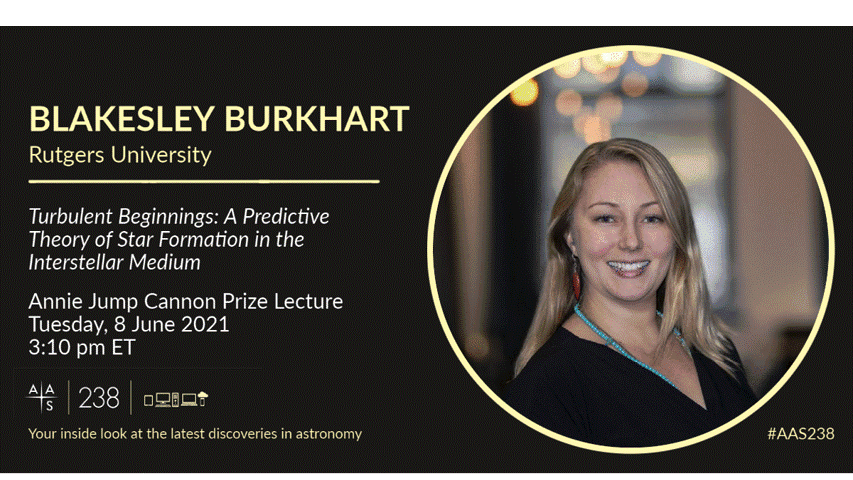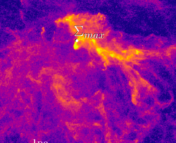In this series of posts, we sit down with a few of the keynote speakers of the 238th AAS meeting to learn more about them and their research. You can see a full schedule of their talks here, and read our other interviews here!

“But what about turbulence?”
This is a question that plagues astrophysicists the world over, and for good reason. It turns out that a mind-boggling variety of astrophysical phenomena can be modelled using the principles of fluid dynamics – from star formation to AGN jets, and from gas dynamics in galaxies to the formation of structure on cosmic scales. While this is an extremely powerful approach, it also means that gaps in our understanding of how fluids behave, such as the mysteries of turbulence, can present significant stumbling blocks in our understanding of these phenomena.
Dr. Blakesley Burkhart, professor of physics and astronomy at Rutgers University, has spent most of her scientific career studying fluid dynamics and the role it plays in governing all kinds of astrophysical phenomena. “We kind of take turbulence for granted, especially in our simulations, but turbulence itself is an unsolved and interesting problem!” exclaims Dr. Burkhart. “There’s this huge range of scales and processes where the fluid dynamics itself and turbulence in particular play a crucial role in setting how we understand these phenomena.”
Her interests in astronomy are incredibly widespread – she has worked in the fields of star formation, the lyman-alpha forest, how solar winds interact with planetary magnetospheres, and lots more. Her Annie Jump Cannon Prize lecture at #AAS238, titled “Turbulent Beginnings: A Predictive Theory of Star Formation in the Interstellar Medium,” will focus specifically on her efforts to model the formation of stars using fluid dynamics and her overall goal of working towards a broad, overarching model of star formation.
A Variety of Research Interests
Prof. Burkhart, jointly appointed at Rutgers University and the Flatiron Center for Computational Astrophysics (CCA), is currently working with her research groups on a veritable cornucopia of questions in astronomy – thinking about star formation, coming up with statistical tools for characterising the properties of turbulence in observations of the inter-stellar medium (ISM), studying polarisation in magnetic fields in regions of star formation, and the application of machine learning tools to come up with new ways of measuring turbulence. While this may seem like quite an assortment of different ideas, they’re actually all “tied back to the fundamentals of trying to understand fluid behaviour in astrophysical systems,” explains Burkhart.
Describing her research group and her approach to mentoring students, Dr. Burkhart says, “It’s been a weird time to be a new faculty member, during Covid-19.” However, her group has grown quickly ever since she started as a new professor at Rutgers in 2019, and she emphasises how important it is for her to have regular meetings with her students and postdocs (both individually and as a group), citing open, honest communication as one of the key aspects of her mentoring philosophy.
She also discusses the nuances of helping her mentees manage their work-life balance. “I tell my students that sometimes they are going to need to push – for proposal deadlines, writing papers, etc., and that’s just how it is in this field. But at the same time I’m trying to build as supportive a group as possible so that we can minimise stress for everybody.” When asked about her advice to undergraduates, she emphasises that public speaking, presenting, and writing are skills that are often just as important as math, science, and coding, and encourages students to get involved in conferences and present their work to others as soon as possible. For grad students, she has the following suggestion: if you have the opportunity to help organise a conference, no matter how big or small, go for it! “On the one hand it’s a lot of work, but on the other hand it’s a fantastic way for everyone in your scientific community to know who you are! Senior people in your field will start recognising you and start paying closer attention to your work.”
Annie Jump Cannon Prize and Career Highlights
On winning the prestigious AAS Annie Jump Cannon Award, Dr. Burkhart says, “It means a lot to be in this group [of prize winners over the years], and it’s humbling and I’m very grateful.” She is also incredibly excited to give her AAS plenary talk, calling it a “once-in-a-lifetime experience.” Given that this is the AAS’ oldest prize, named in honour of the iconic astronomer Annie Jump Cannon herself, makes it extra special for Dr. Burkhart. “You look at the list of winners of this prize, and you think, ‘wow, it’s amazing that I’m now among these incredible scientists’ – people that not only did incredible science but also paved the way for women in astronomy.”
Prof. Burkhart recalls her beginnings in small-town Kentucky and expresses pride in her personal and professional accomplishments since then. Coming from a family of farmers and schoolteachers, she had always been asked about how she would get a “real job” after studying astrophysics. Yet her desire to learn more and study physics and astronomy persisted, taking her to the University of Louisville for her undergraduate career, during which she also participated in REU’s and other summer research programs. Dr. Burkhart refers to those experiences as being instrumental in connecting her with researchers and faculty at bigger schools and departments known for their contributions to astronomy.
Citing her Ph.D adviser at the University of Wisconsin-Madison, Prof. Alex Lazarian, as a tremendous source of support and inspiration, Burkhart mentions that her success is in significant part also because of the good mentoring she has received over the years. This combination of personal drive, support and encouragement from mentors, and an innate curiosity about natural phenomena has led her to where she is today – becoming an astrophysics professor, winning a renowned AAS prize, and doing groundbreaking research in unravelling the mechanisms underlying the formation of stars in galaxies.
Looking Ahead
Talking about one of her research goals she is most excited about, Dr. Burkhart mentions how the astronomy community has reasonably good theories of how star formation works, but they each work well in certain regimes and break in others. She describes how both simulations and observations of star formation are effective from parsec scales down to scales of circumstellar disks, but there is no single, complete, analytic model of star formation that spans all the scales and is agreed upon by the entire community. She also points out how coming up with a complete star formation theory would not only be an amazing result by itself, but also have broad-reaching implications all the way from planet formation to cosmological simulations. “My dream is to come up with a unified analytic model of star formation that works from the smallest scales of individual molecular clouds all the way up to galactic scales. I’m not there yet, but that’s definitely my dream!”
To learn more about Prof. Burkhart’s work on modelling turbulence and seeking a generalised theory of star formation, check out her Annie Jump Cannon Prize lecture at 3:10PM ET on Tuesday, 8th June at #AAS238!

Astrobite edited by: Sabina Sagynbayeva
Featured image credit: American Astronomical Society


